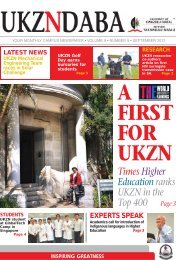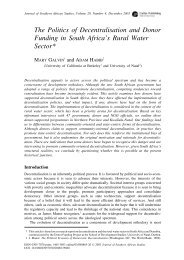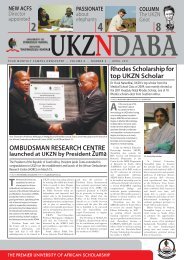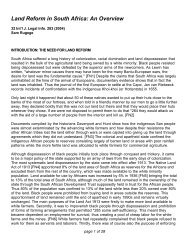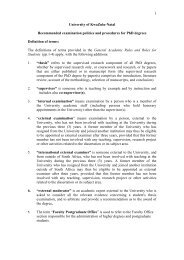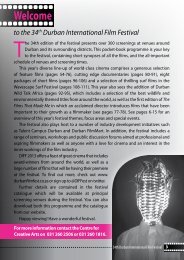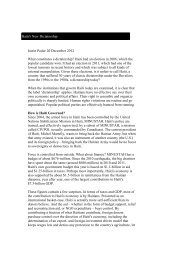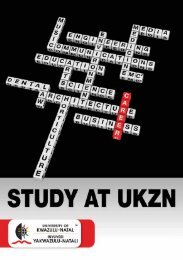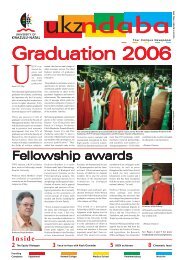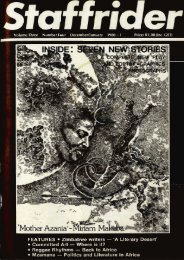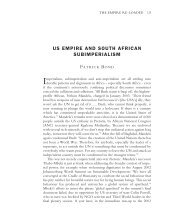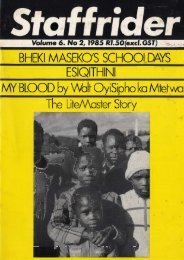Staffrider Vol.3 No.1 Feb 1980 - DISA
Staffrider Vol.3 No.1 Feb 1980 - DISA
Staffrider Vol.3 No.1 Feb 1980 - DISA
- No tags were found...
You also want an ePaper? Increase the reach of your titles
YUMPU automatically turns print PDFs into web optimized ePapers that Google loves.
Gallery ProfileBehind the Lens: JUDAS NGWENYAThe first in a series of interviews with<strong>Staffrider</strong> photographers and graphicartists about themselves and their work,and how they see it in relation tocultural struggle as a whole.I started taking pictures in 1968while I was still at school. Someone lentme a polaroid and when he took it backI was very sad. I bought an instamaticand started using it for black and whitepictures. I photographed children, parties,school-groups. I was still learning,so I didn't charge professional prices, Ijust said, "If you've got 25c it's O.K."In 1970 I bought a good camera. Istarted using colour, and taking photographsof adults: parties, weddings,funerals, competitions. I charged 75c aprint. At this time I was working atCheckers as a packer, so all the photographywas done in my spare time.I didn't think that commercialphotography would take my aims as aphotographer further, but I used themoney to buy photography books so Icould study.In 1973 I resigned from Checkersand started free-lance work. By now Iwas well-known as a wedding/partyphotographer. But I was tired of weddings.I wanted to learn printing andmore advanced techniques, so that Iwould be competent enough to takemore relevant pictures, and I started acorrespondence course in photography.One day, a few years later, I was takingmy granny to Baragwanath hospital.I had my camera with me. It was about10 a.m. I saw a lot of children shouting'Power'. I didn't know what was happening... I wanted to take photographsbut I was scared and confused.There were a lot of police but somethingkept telling me, if I'm a photographerI must take these pictures.I heard taxis hooting, and then I sawdead children on stretchers being carriedout of the taxis. I was helping to carrythe stretchers to the hospital but at thesame time I was seeing colours, colourseverywhere . . . Men in white coats,nurses in blue-striped uniforms, some ingreen and red stripes, men in white andblue overalls. And I kept thinking, Tvegot a colour film in my camera'. But Ialso felt I must help in the situation,and when the hippos came I just ran tothe car. I was very scared. By this time Ihad lost my grandmother: I only foundher the following day at Dube policestation. This was my experience ofKliptownbackyardJune 16th 1976. It was a Wednesday . . .I wanted pictures so that I couldlook back at events and see clearly whathad been happening. But I also knewthat when I took the film to be processedI probably wouldn't get itback. I now know that it's not easy totake photographs in those situations.But Magubane, Moffat Zungu, RalphNdawo . . . they did it. And I've learnedabout how important photographs arein documenting people's lives. Theyremind us of our history: what's happenedbefore and what's going tohappen in the future.In 1978 I got a diploma in photographyfrom a correspondence courseI'd been doing. The diploma's importantto me because it has proved to me that Iunderstand some of the theory of mywork.Then I joined the photography workshopat the Open School. That waswhere I finally learned how to developand print my own work. I won a pocketcamera in a competition: this encouragedme a lot. If you're takingpictures, you need people to see yourwork and react to it, otherwise youdon't make progress. To take pictures isto learn, and to see what the lives of thepeople are like: most are suffering,though some aren't. People have verydifferent existences, and photographs18 STAFFRIDER, FEBRUARY <strong>1980</strong>



